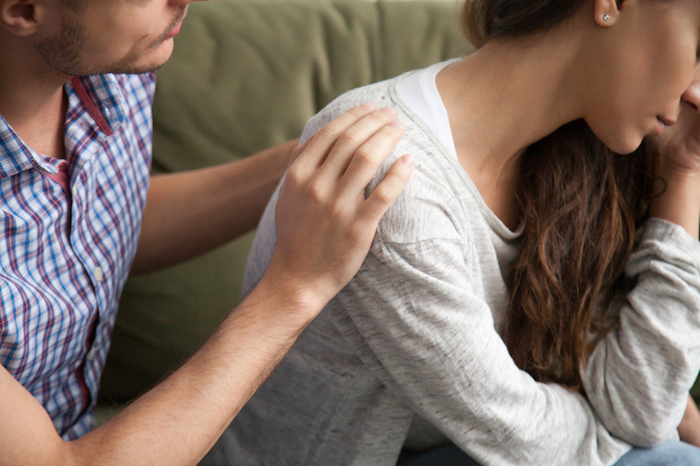- Calls to this hotline are currently being directed to Within Health or Eating Disorder Solutions
- Representatives are standing by 24/7 to help answer your questions
- All calls are confidential and HIPAA compliant
- There is no obligation or cost to call
- Eating Disorder Hope does not receive any commissions or fees dependent upon which provider you select
- Additional treatment providers are located on our directory or samhsa.gov
Identify the Signs of Bulimia in a Loved One
If someone in your family is struggling with bulimia, chances are, they are very skilled at hiding it. As with other eating disorders like anorexia and binge eating disorder, those dealing with bulimia typically do so in secret. When confronted with life stressors or tension developed from restricting food intake, those suffering from bulimia comfort their emotions through a process known as “binge and purge.”
In this cycle, a person takes in large quantities of food (1,000-5,000 calories) in a short time period. If the person is on a diet, when the “forbidden” food is consumed, people with bulimia engage in compulsive behaviors like consuming much more in order to dull the unwanted feelings. Now full beyond comfort or satisfaction, fear of weight gain sets in. Purging is a technique that allows people to quickly rid the body of unwanted calories through the use of self-induced vomiting, laxative and diuretic abuse, and excessive exercise.
These various ways of purging create a cycle that causes the person struggling with bulimia to feel yet more shame and lack of personal control(2). Strict dieting is then enforced until the next cycle begins. Typical feelings experienced in every binging and purging cycle are feelings of fear, shame, and guilt. It is no surprise that this ritual is performed in private often late at night while family members sleep or during times of the day when no one is home. Be aware of disappearances after meals, even if they are not to a bathroom. Your loved one may have another special place they go to in order to hide their secrets.
There are many misconceptions about eating disorders that allow the disease to flourish in plain sight.
- “She doesn’t look too skinny.” Or “he says he hasn’t eaten all day, of course he’s hungry!” There is no size requirement in the diagnosis of bulimia. A person struggling with anorexia who also exhibits bulimic behaviors may be on the noticeably thinner side, but many struggling with bulimia look average build or are slightly overweight.
- Purging does not prevent weight gain. Vomiting after a meal, at best, can rid the body of only 50% of the calories eaten(3). Other forms of purging are even less effective. It is also fairly common to restrict food intake throughout the day in order to binge later.
- People struggling with bulimia may purposely restrict their food intake, so that it is more socially acceptable to binge in public. The health consequences may not be visible from the outside except to the trained eye.
While someone coping with bulimia may not look like they are starving to death on the outside, the tell-tale signs are:
- Discoloration of teeth
- Red bloodshot eyes
- Puffy cheeks
- Neck calluses on knuckles from induced vomiting
- Weight fluctuation(3).
Irregular heartbeat, kidney failure, and a ruptured esophagus can be complicating factors that lead to early death.
Maybe you are getting that feeling in the pit of your stomach and you know something is peculiar about your loved one’s behavior, but you do not know how to bring it up, and instead hope that it will disappear on its own. It won’t. Eating disorders will only get worse if left untreated. Eating disorders come from a place in our minds where we are struggling to cope with the following:
- Self-esteem
- Life changes
- Body image(1)
The “control,” a person with bulimia feels while managing their food and bodies is hard to give up. Your compassion, understanding, and willingness to talk with your loved one about getting professional help are key to their recovery(2). While they may feel defensive and unwilling to give up their way of coping with their world at first, knowing that you care enough to have that hard conversation can be the difference in achieving recovery from an eating disorder(1).
Resources
- Brisman, Judith, Michele Siegel and Margot Weinshel. Surviving an Eating Disorder, Third Edition: Strategies for Family and Friends. Harper Perennial; 3 Rev Upd edition. 2009. Print.
- McShane, Johanna Marie and Tony Paulson. Why She Feels Fat: Understanding Your Loved One’s Eating Disorder and How You Can Help. Gurze Books; Revised edition, 2008. Print.
- Segal, Ph.D., Jeanne and Melinda Smith, M.A. “Bulimia Nervosa: Signs, Symptoms, Treatment, and Help.” Helpguide.org, 2012. Web. January 2012. http://www.helpguide.org/mental/bulimia_signs_symptoms_causes_treatment.htm
Contributed Article by Courtney Kent, BA, Outreach Director, New Dawn, Marybeth Weinstock, PhD, Therapist, New Dawn, & Victoria Green, MFT, Clinical Director, New Dawn
Published Date: April 12, 2012
Last reviewed: By Jacquelyn Ekern, MS, LPC on 12 June, 2012
Page last updated: June 12, 2012



